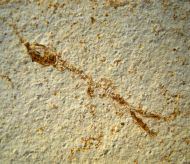Fossils for sale
Fishes from the Solnhofen Limestione.

Fossil Fishes from the Solnhofen Limestone
The fishes from the Solnhofen limestones are renowned for their exceptional preservation. In addition to complete skeletons, there are often remains of soft tissues, color patterns, and even stomach contents. Particularly remarkable is the evidence of parasites, such as parasitic isopods of the genus Palaega, preserved on or within their hosts. These finds provide unique insights into the ecology of the Late Jurassic.
Systematic Overview
| Group | Representative taxa (examples) | Special features |
|---|---|---|
| Teleosts (Teleostei) | Leptolepides sprattiformis, Tharsis dubius, Ascalabos voithii | Most common group; often completely preserved; schooling fishes and medium-sized predators; important index fossils. |
| Holosteans (Holostei) | Aspidorhynchus acutirostris, Belonostomus, Gyrodus, Gyronchus, Caturus | Predators with elongated snouts; pycnodonts with crushing teeth; spectacular finds such as Aspidorhynchus entangled with a pterosaur wing. |
| Chondrosteans (Chondrostei) | Coccolepis bucklandi, Coccolepis liassica | Very rare; primitive ray-finned fishes with cartilaginous skeleton and enamel scales; document early stages of actinopterygian evolution. |
| Cartilaginous fishes (Chondrichthyes) | Asteracanthus, Synechodus, rays | Often preserved with dermal denticles and fin spines; illustrate the diversity of Jurassic sharks and rays. |
| Coelacanths (Crossopterygii / Actinistia) | Macropoma, Coccoderma, Holophagus | Very rare; important group for the evolution of bony fishes; characteristic fin anatomy; scientifically highly significant. |
Diversity
To date, around 60–70 genera of fishes have been described from the Solnhofen limestones, comprising several hundred species. Fishes are therefore among the most common vertebrate fossils of this deposit and document a complete ecosystem ranging from small schooling fishes to large predators.
Depositional Conditions
The exceptional preservation of the fishes was only possible due to the special conditions of the lagoons:
- Oxygen-poor bottoms prevented scavenging and decay.
- Hyposaline conditions hindered the survival of benthic organisms.
- Minimal water movement led to finely laminated sedimentation.
- Algal mats stabilized the lime mud and aided in the conservation of carcasses.
Predator–Prey Relationships
Particularly striking are finds that document direct interactions:
- Aspidorhynchus that perished while attacking a pterosaur wing.
- Fishes with preserved stomach contents (e.g., smaller fishes, crustaceans).
- Evidence of parasites such as Palaega on host fishes.
References (Primary Literature)
- Arratia, G. (1997): Basal teleosts and teleostean phylogeny. Palaeo Ichthyologica 7: 1–168.
- Arratia, G. & Tischlinger, H. (2010): The Solnhofen (Late Jurassic, Germany) actinopterygian fish fauna revisited. Zitteliana B 30: 67–95.
- Bartram, A.W.H. (1977): The holostean fish genus Caturus from the Upper Jurassic of Europe. Palaeontology 20: 33–75.
- Lehmann, W. (1966): New finds of fishes from the Solnhofen limestones. Neues Jahrbuch für Geologie und Paläontologie, Abhandlungen 125: 1–59.
- Tischlinger, H. & Arratia, G. (2013): Exceptional soft-tissue preservation in fishes from the Upper Jurassic of Germany. Proceedings of the Geologists’ Association 124: 604–617.
